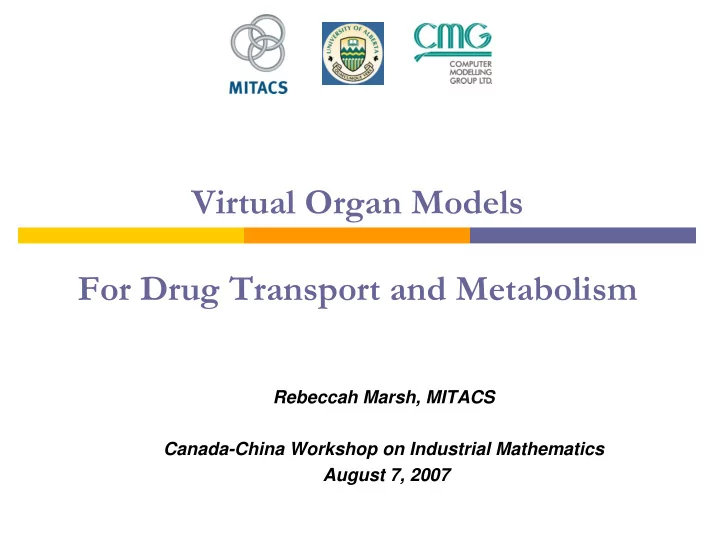

Virtual Organ Models For Drug Transport and Metabolism Rebeccah Marsh, MITACS Canada-China Workshop on Industrial Mathematics August 7, 2007
Overview I. Pharmacokinetic Modeling II. Methods III. Angiogenesis and Vascular Networks IV. Liver Lobule V. Virtual Organ VI. Future Directions
I. Pharmacokinetic Modeling
Pharmacokinetics the ensemble of drug molecules the interaction matrix the medium
Challenges Effectiveness of a drug relies on: Transport processes Reaction processes Body tissues are highly heterogeneous Physiological processes typically involve many complex chains of reactions Lab experiments and clinical trials are time- consuming, costly, and potentially harmful.
Compartmental Modeling k 12 k = kinetic rate coefficient C 1 C 2 k 21 Conditions Homogeneous Heterogeneous C kC Linear reaction v C max Enzyme-mediated C K C reaction M
Compartmental Modeling k 12 k = kinetic rate coefficient C 1 C 2 k 21 Conditions FRACTAL Homogeneous Heterogeneous KINETICS h C kC C k t C Linear reaction 0 X v C v C max Enzyme-mediated max C C X K C reaction K C M M
Objectives of “Virtual Models” Develop physiologically-accurate models Investigate the behaviour at different scales Both spatial and temporal scaling Test compartmental predictions Develop a simulation platform and a visualization tool Start with the liver: main site of drug metabolism
II. Methods
STARS ( Computer Modelling Group Ltd.) Advanced process simulator Models the flow of multi-phase, multi-component fluid in porous media Employs: Mass and energy conservation Equations of state Poiseuille flow Darcy’s Law Pressure differences can be due to thermal, mechanical, or chemical processes
Example: Simulation of Oil Extraction
Model Components Grid Geometry and dimensions Permeability and porosity of each grid cell “Rock and fluid” properties “water” and “oil” components Density, chemical composition, viscosity, melting point, etc. Relative permeabilities Reactions Initial conditions Distribution of components in the grid cells Wells - injectors and producers Location on grid Upper pressure boundary and/or flow rate Times at which to record data
III. Angiogenesis and Vascular Networks
Angiogenesis
Movement of Glucose Through the Vessels t = 0 min t = 0.02 min t = 0.14 min t = 0.25 min t = 0.4 min t = 0.61 min
Transient Fractal Kinetics in the Outflow 6 10 1 0 10 10 8 10 Glucose (molar fraction) 10 10 12 10 14 10 16 10 Time (min)
IV. Liver Functional Unit
The Lobule http://www.niaaa.nih.gov/NR/rdonlyres/
Physiologically-Based Network Model Vasculature Hepatocytes
Image-Based Model
Simulation of Drug Metabolism
V. Virtual Liver
CT Scan of An Abdomen
High-Resolution CT Scan
Virtual Liver
Liver vasculature
Glucose Transport Through the Liver
VI. Future Directions
Multi-Scale Modeling lobule liver whole body hepatocyte
Future Directions Compare results with experimental data Model zonation of lobule Model other organs Kidney, GI tract, lung, brain, heart, gallbladder, etc. Model tumours and their vasculature Model processes at the cellular or subcellular levels Connect organs into a virtual full-body model
Recommend
More recommend